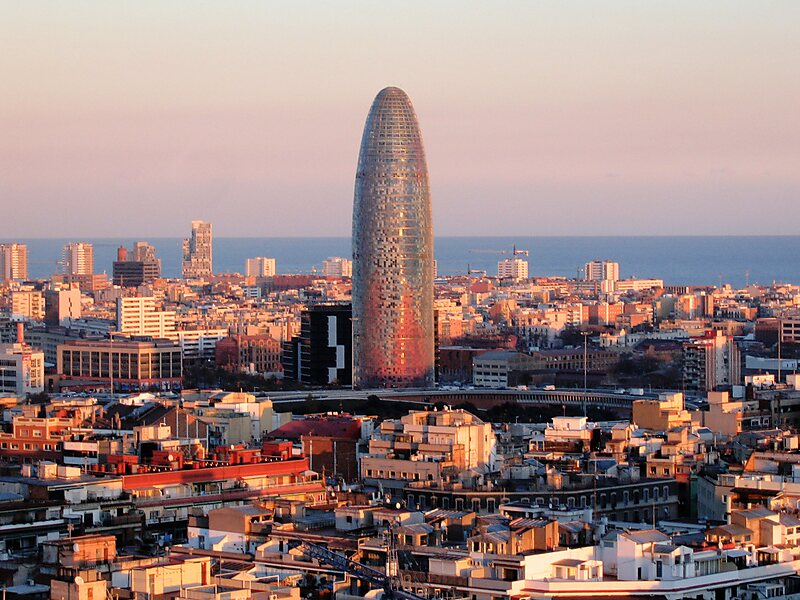Catalonia (Barcelona, Tarragona, Girona, Lleida, Sitges) Feb 12- 16 2019
LLEIDA
Cathedral of St. Mary of La Seu Vella (Turó de la Seu Vella de Lleida). A tentative World Heritage Site (2016) is the former cathedral church of the Roman Catholic Diocese of Lleida located on top of Lleida hill. In 1707, the Gothic cathedral was turned into a military citadel by the decision of King Philip V of Spain. The new cathedral, known as the Seu Nova (New See) and located downhill was consecrated in 1781. The Seu Vella is the defining monument of Lleida, the symbol of the city, being visible from its hilltop site anywhere in the city.
Consecrated to the Virgin Mary in 1278, the cloisters are 14th century and the bell tower was finished in 1431. In 1707, the city was conquered by the troops of Philip V: the king ordered the destruction of the cathedral because it had taken a prominent part in the city’s defence. Nevertheless, the order was never executed, and the cathedral was converted into barracks. The building was declared a national monument in 1918, and restoration works were started in 1950.
It lacks almost any influence of Islamic architecture. The floor plan is of a basilica in a Latin cross with a nave and two aisles. The 60m tall bell tower is 12.65m in diameter at its base and 9.62m at the top.
The cloister is unusually placed in front of the main entrance of the church, has a rarely opened gallery with views over the city and is one of the largest cloisters in Europe. It has 17 ornate Gothic windows, each of them different, one a Muslim window of “the palm trees” and the central one includes both a King David’s Star and a Christian cross. €3
 Lleida Museum. This modern museum was built around the chapel of the 1595 Discalced Carmelite Convent. The first floor is religious pieces and the top archaeology with an emphasis on human evolution. €2.50 reduced
Lleida Museum. This modern museum was built around the chapel of the 1595 Discalced Carmelite Convent. The first floor is religious pieces and the top archaeology with an emphasis on human evolution. €2.50 reduced
Poblet Monastery. Founded in 1150 by Cistercian monks from Fontfreda in France, it became the burial site of the Catalan-Aragonese dynasty. It was abandoned in 1835 until Italian Cistercians returned in 1940. 26 monks still reside here. It was designated a UNESCO World Heritage Site.
I arrived at 10:25, just in time for the first tour at 10:30. The guide unlocked all the doors and let me self-guide through the monastery following the excellent brochure in English. The monastery is enclosed in an 11m wall that is 608m long (14th century). Enter through the Royal Gate with its Baroque façade. The Cistercians believed in design simplicity and there is little decoration to all the rooms. All have vaulted roofs supported by arches and rib vaulting. Off the atrium is the winery (14th century), Lay Refectory (14th-century wine cellar), cloister (12th-14th centuries) with its gardens and fountain covered by a domed pavilion, kitchen, Monk’s Refectory (wood-panelled, the tables were set for lunch), library, the huge empty Monk’s dormitory with access to the upper cloister, and Chapter House. The highlight is the 12th-century High Church with its 14th and 15th-century pantheon of Catalan-Aragonese Count-Kings. Unusually, the tombs are on the slanted roof of a church on top of two, low arches. Eight kings and 6 consort queens. The 16th-century alabaster altarpiece has the figure of St Mary of Poblet holding the infant Jesus.
TARRAGONA
Tarragona was first occupied by the Romans, who called it Tarraco, in 218 BC; prior to that, the area was first settled by Iberians, followed by Carthaginians. Scipio launched his successful military endeavours from here, and in 27 BC Augustus made it the capital of his new Tarraconensis province (roughly all of modern Spain) and stayed until 25 BC, directing campaigns. During its Roman heyday, Tarragona was home to over 200,000 people, and though abandoned when the Muslims arrived in AD 714, the city was reborn as the seat of a Christian archbishopric in the 11th century.
The narrow alleys of the historic quarter remain untouched since medieval times.
Archaeological Ensemble of Tárraco. The entire city of Tarragona is a UNESCO World Heritage Site with extensive Roman ruins and medieval and modern structures. The Roman sites are the highlight with a Theatre sitting on the shore (the stage, orchestra, and seating are still intact), a Forum with remains of the basilica, a Roman street, and a grand aqueduct.
National Archaeological Museum of Tarragona (MNAT). In the old quarter, it was closed for renovation but its best exhibits were on show at Tinglado 4, an attractive building at the port. €7, €4 reduced
included in the ticket are the necropolis and the villas at Centcelles and Munts.
Modern Art Museum. Located in the centre of the old quarter near the archaeology museum, this had many enjoyable pieces, not just the usual large installations of abstract junk. The highlight was the sculpture of Julio Antonio (1889-1919).
Museo d’Historia de Tarragona. Next to the closed Archaeology Museum, this sits in a tower with Roman foundations under a royal 14th-century medieval residence – the top has the best views in town. A great barrel vault extends from the ground floor. €7 for all the Roman Sites in nearby.
Museu i Necròpolis Paleocristians. This vast Roman-Christian city of the dead on the western edge of town consists of over 2000 elaborate tombs. It was used from the 3rd century AD onwards, after Rome’s conversion to Christianity. The museum discusses the beliefs, rituals, ceremonies and customs relating to death in the Roman period. Entry is free if you have already purchased a ticket to the Museu Nacional Arqueològic de Tarragona.
Passeig Arqueològic Muralles. These walls take you around part of the perimeter of the old town between two lines of city walls. The inner ones are mainly Roman and date back to the 3rd century BC, while the outer ones were put up by the British in 1709 during the War of the Spanish Succession. The early stretches are a mighty 4m thick. The Iberian gateways and battlements give good views of the city. The walk starts from the Portal del Roser where Avenida Catalunya touches the old town.
Aqüeducte de les Ferreres. This aqueduct is 4km north of central Tarragona, just off the AP7 freeway (near where it intersects with the N240). It is a fine stretch of two-tiered aqueduct (217m long and 27m high), along which you can walk to the other side.
Villa Romana de Centcelles. 6 km north of Tarragona, it has an almost completely preserved dome mosaic with a Christian theme in the Roman world, dating from the 4th century.
Torre dels Escipions. 6 km east of Tarragona, this is a tower-shaped funerary monument on the Via Augustus built in the 1st century. Made of three bodies, the middle has two figures of Attis, a divinity related to funeral rites.
El Medol. 10 km east of Tarragona, this Roman stone quarry has a 20m monolith.
Villa Romana dels Munts. 12 km east of Tarragona, sitting on the shore, has great decorated living areas, baths and mosaics.
Arch de Bera. 20 km NE of Tarraco, this honorific arch on the Via Augustus was built between 15 and 5 BC of local stone and has an inscription referring to its construction.
PortAventura. A massive amusement park, it is 7km west of Tarragona. Divided into themed sections, the park has many exhilarating rides and numerous shows. It boasts Shambhala, Europe’s highest rollercoaster, as well as Costa Caribe Aquatic Park with great slides. There are various combined and multiday tickets available and themed on-site. €45
REUS
Gaudi Center. Gaudi was born in Reus, just NW of Tarragona. This is a 3-story interpretive center that added little to my knowledge of Gaudi which is well documented at Familia Sagrada and throughout his architecture in Barcelona but does use hands-on interactive models. It closes from 2-4 every afternoon. €9, €5 reduced
La Casa Navàs. Also in Reus, this house is built in Art Nouveau style, this is a wonderful house well worth the visit. Monday to Saturday closed over lunch and dinner. €5
BARCELONA
History. Founded by the Carthaginians in about 230 BC. Roman Barcelona (Barcino) covered an area within today’s Barri Gòtic and was overshadowed by Tarraco (Tarragona), 90km to the southwest. In the wake of Muslim occupation and then Frankish domination, the House of the Counts of Barcelona was founded in 878. In 1137 Count Ramon Berenguer IV married Petronilla, heiress of Aragón, creating a joint state and setting the scene for Catalonia’s golden age. Jaume I (1213–76) wrenched the Balearic Islands and Valencia from the Muslims in the 1230s to ’40s. Jaume I’s son Pere II followed with Sicily in 1282. After the accession of the Aragonese Fernando to the throne in 1479 and his marriage to Queen Isabel of Castilla, Catalonia effectively became a subordinate part of the Castilian state. After the War of the Spanish Succession (1702–13), Barcelona fell to the Bourbon king, Felipe V, in September 1714.
The 19th century brought economic resurgence. Wine, cotton, cork and iron industries developed, as did urban working-class poverty and unrest. To ease the crush, Barcelona’s medieval walls were demolished in 1854. The flourishing bourgeoisie paid for lavish buildings, many of them in Modernisme style, whose leading exponent was Antoni Gaudí. In 1937, a year into the Spanish Civil War, the Catalan communist party took control of the city. Barcelona fell to Franco in 1939 and there followed a long period of repression.
Under Franco, a flood of 750,000 immigrants, chiefly from Andalucía came, many living in appalling conditions. In 1975, a new Spanish constitution created the autonomous community of Catalonia, with Barcelona as its capital. The 1992 Olympic Games put Barcelona on the map. Under the visionary leadership of popular Catalan Socialist mayor Pasqual Maragall, a burst of public works brought new life to Montjuïc and the once shabby waterfront. Flush with success after the Olympics makeover, Barcelona continued the revitalisation of formerly run-down neighbourhoods.
In 2013, on the Catalan National Day (11 September), hundreds of thousands of separatist supporters formed a 400km human chain across Catalonia. In 2014, a referendum on independence took place, though Spanish judges have said such a vote was illegal and violates the constitution. Whether or not Catalonia will gain its independence, Barcelona will continue to chart its own course ahead.
TIPS for BARCELONA
1. Robbery. Barcelona is probably the worst place in the world for personal crime. As one of the biggest tourist destinations, tourists are prime targets for thieves with the Metro and La Rambla the common places. They are often not aware of this issue and have developed many bad security habits. There is a large Romani population here; it has attracted people from all over the world to relieve you of your property. Thieves work in groups – one distracts and the other pickpockets you.
On my first trip to Barcelona in 2010, my iPhone was pickpocketed. On my third trip, my camper van’s rear window was smashed and only a Kindle was stolen. Report to the police but don’t expect to get your property back, it is only for a police report for insurance purposes.
a. Personal security. Wallets, phones, passports, cameras, and packs must all be in places thieves can’t access – secret pockets sewn into the inside of pants are the safest. Have only enough money to spend on that journey. Don’t bring your big SLR to these places.
b. Vehicles. Ones with foreign license plates and rental cars are prime targets as these will most likely leave things in the vehicle. The locals leave nothing visible. Many leave their vehicles unlocked (and empty) to avoid having windows smashed.
2. Barcelona Art Passport. Supposedly, the six best art museums in Barcelona (M Picasso, CCCB, MACBA, Antoni Tapies, Joan Miro and Museo Nacional d’Art de Catalunya) €30, a total value of €58. Personally, I would never buy this pass, none of these museums are that great as 5 are primarily abstract art. There are also 5 and 3 museum passes. Spain has to figure out museum passes – most cities offer all museums for 1, 2 or 3 days.
Day 1
Hotel Porta Fira. In south Barcelona, this hotel stands out – red, round and enlarges towards the top.
L’Ateneu. This homey bar/restaurant is in the 1924 L’Ateneu Familiar, a community centre in Sant Vicenç, a neighbourhood in SW Barcelona. The food was cheap and good and entertainment is regularly provided.
Day 2
I slept at the Mirador de Serra, possibly the best panoramic viewpoint above Barcelona. By a bizarre combination of events, I locked myself out of my van when taking a short pee. A lovely couple, law students in Barcelona, came to my rescue, called the Spanish Automobile Association who opened the van – 1½ hours later for €80. They phoned and waited the entire time. Sunrise was lovely. Oh well, another stupid adventure.
Park Natural de la Serra de Collserola.
Funicular Valliudera. This is between the Barcelona community of Valliudera and the almost top of the mountain, part of the Barcelona transit system. €2.60 one way.
Torre de Collserola. This huge, triangular telecommunications mast sits on top of the mountain. The official lookout is not open in January/February but I walked around the base to the free mirador, whose views were obstructed by some trees. €5.60 for the lookout and €16 for
Funicular Tibidabo. This ascends the mountain east of Valliudera. It has been out of service for some time. Alternate bus routes are posted at the gate.
Tibidabo Amusement Park. Located in Tibidabo in the Collserola Ridge, it was built in 1899 by the entrepreneur Salvador Andreu and opened in 1905. The park is among the oldest in the world still functioning. It is Spain’s longest-running amusement park and Europe’s third-oldest. Most of the original rides, some of which date to the turn of the 20th century, are still in use. The park is now owned by the Barcelona City Council.
A popular ride at the park is the 1928 Avió airplane ride, a single-car carousel giving the impression of flight above the city, a novelty at the time. Riders board a replica of the aircraft that first flew from Barcelona to Madrid. The park was featured in the Woody Allen film Vicky Cristina Barcelona.
Tibidabo’s Automata Museum on-site houses more than 40 mechanical figures from the 19th and 20th centuries.
The funicular ends near here if it is still functioning.
Tramvia Blau. This hop-on-hop-off bus drives through the western part of the city stopping at several “attractions” from 09:30-19:45, but is very expensive €30, €25 reduced for one day.
Hiroshima. This lovely park in the city has nice walkways, many benches, a playground and nice trees, mostly pine and palms. A “racquetball court was busy, people were walking their dogs and old men surrounded by several spectators (sounds like China) were playing cards on 2 picnic benches in the sun.
La Maquinista. This shopping mall is not on Google Maps – I was led through a maze of narrow streets to a small apartment building.
Enigmik Escape Room. You get 60 minutes to rescue Dr. Betsy Smith (who is in danger) from the maximum-security secret bunker. €13 Buy a T-shirt for €10
Mercat Fira dells Encants Vells. Under the huge train station with a multi-mirrored roof, this is a flea market that starts Friday at 9 am.

Torre Glòries, formerly known as Torre Agbar is a skyscraper/tower that marks the gateway to the new technological district of Barcelona. It was originally named after its owners, the Agbar Group, a holding company.
It is 144.4 m in height and consists of 38 stories, including four underground levels. The tower measures a total of 50,693 m2 (545,650 sq ft), of which 30,000 m2 are offices, with the rest an auditorium, and 9,132 m2 of parking space. The building stands out in Barcelona; it is the third tallest building in the city, after the Arts Hotel and the Mapfre Tower, which both are 154 m tall.
It cost €130 million to build, opened in 2005 and in 2017 was purchased by Merlin Properties real estate group and then renamed Torre Glòries after the name of the adjacent square. It houses the head office of the Aigües de Barcelona Group, the water supply company of Barcelona.
It has a phallic character and as a result of its unusual shape, the building is known by several nicknames, such as el supositori (“the suppository”), l’obús (“the shell”) and some more scatological ones.
Its design combines a number of different architectural concepts, built with two concentric concrete oval cylinders that do not come in contact with each other. The inner cylinder is where the lifts, stairs and facilities are located. The outside is covered with a facade of glass louvres, and over 4,500 window openings are cut out of the structural concrete. A defining feature of the building is its nocturnal illumination by 4,500 LEDs capable of creating 16 million colours that can operate independently enabling the generation of images on the outside of the tower. In addition, the outside of the tower has temperature sensors that regulate the opening and closing of the window blinds of the façade, reducing the consumption of energy for air conditioning and altering the colour balance of the tower as a function of time of day and season of the year. During Christmas, New Year and other events the tower changes colour in animated computer-controlled sequences. This has become the venue chosen by thousands of locals and visitors to the city to welcome the New Year and has allowed Barcelona to begin to appear on television around the world alongside other famous landmarks.
The tower has twice been climbed by Alain Robert. The first, on 3 August 2006, was an action that sought to call for peace in the conflict in Lebanon.
Design Museum of Barcelona (Museu del Disseny). In a new 4-story building moved into in 2014, this is an excellent museum with great general exhibits showcasing Spanish design. The temporary exhibit was on commercial advertising with a great collection of signs, the nicest were the ones made of tiles. Other displays were on furniture, clothing (good explanation of clothing design from 1800 on, concentrating on women’s high fashion) €6, €4 reduced.
Mercat Fira Els Encants. Encants is a large space with a multi-level mirrored roof. It holds a flea market that opens at 9 am on Fridays. It is a rambunctious affair with lots of low-cost things.
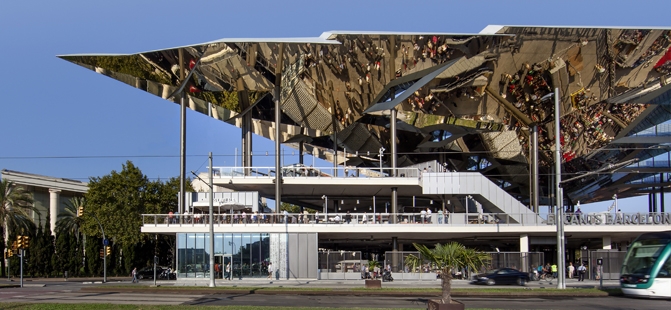
I took the Barcelona Tram the 1.8 from here to the next attractions.
Passeig de Gracia. In the NM “metros, trams and funicular” series, this is hard to understand – it is a plain metro station but centred around one of the few roundabouts in Central Barcelona, with a grand fountain in the middle.
Fundació Antonio Tàpies. Antonio Tapies (1923-2012) was a well-known Spanish artist at the forefront of abstract art. The exhibit shows 50 pieces from work from 1946-77, a political biography drawn from his memoirs. here are some nice drawings, but the rest is best not seen – installations made of wood, burlap, straw, string and cardboard. The temporary exhibit was Erkan Özgen, a Turkish videographer (4 videos, two very long 12”, 16”, 4’ 50”, and 3’ 54”) documents the impact of violence and war. €7
Center de Cultura Contemporaria. The only exhibit was on Stanley Kubrick, best known for his movie A Clockwork Orange, showing a chronological tour of his work, including his large photography collection from the 1940s to 50s centred on New York City – everyday life, boxers, Ringling Brothers Circus, celebrities. €6, €4 reduced.
MACBA Museum Contemporary Art. I tend to not enjoy abstract art, but this had many nice pieces of sculpture. The outside plaza is the local skateboard hangout. €11.50, €8 reduced.
Palace de la Musica Catalonia (Palace of Catalan Music) is a concert hall designed in the Catalan modernista style. It was built between 1905 and 1908 for the Orfeó Català, a choral society founded in 1891 that was a leading force in the Catalan cultural movement. The project was financed primarily by society, but important financial contributions also were made by Barcelona’s wealthy industrialists and bourgeoisie.
In 1997, it was declared a UNESCO World Heritage Site along with Hospital de Sant Pau. Today, more than half a million people a year attend musical performances in Palau that range from symphonic and chamber music to jazz and Cançó (Catalan song).
Catalan modernism is characterized by curves predominating over straight lines, dynamic shapes are preferred over static forms, and rich decoration that emphasizes floral and other organic motifs is used extensively.
The façade is richly decorated in traditional Spanish and Arabic architecture. The exposed red brick and iron, the mosaics, the stained glass, and the glazed tiles. Two colonnades on the second-level balcony of the main façade are covered in multicoloured glazed tile in mostly floral designs and is capped with a candelabrum that at night blazes with light (see photograph). The top has a large allegoric mosaic but it is impossible to see clearly from the narrow street below.
The concert hall seats about 2,200 people and is the only auditorium in Europe that is illuminated during daylight hours entirely by natural light. The walls on two sides consist primarily of stained-glass panes set in magnificent arches, and overhead is an enormous skylight of stained glass. The hall is not a theatre, because the massive sculptures flanking the stage make the use of scenery nearly impossible. €20, €16 reduced.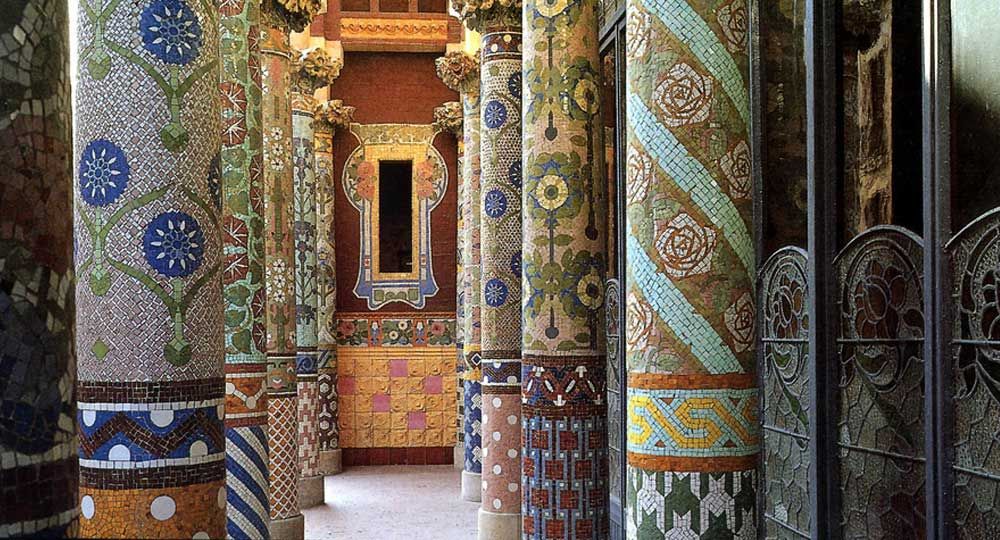
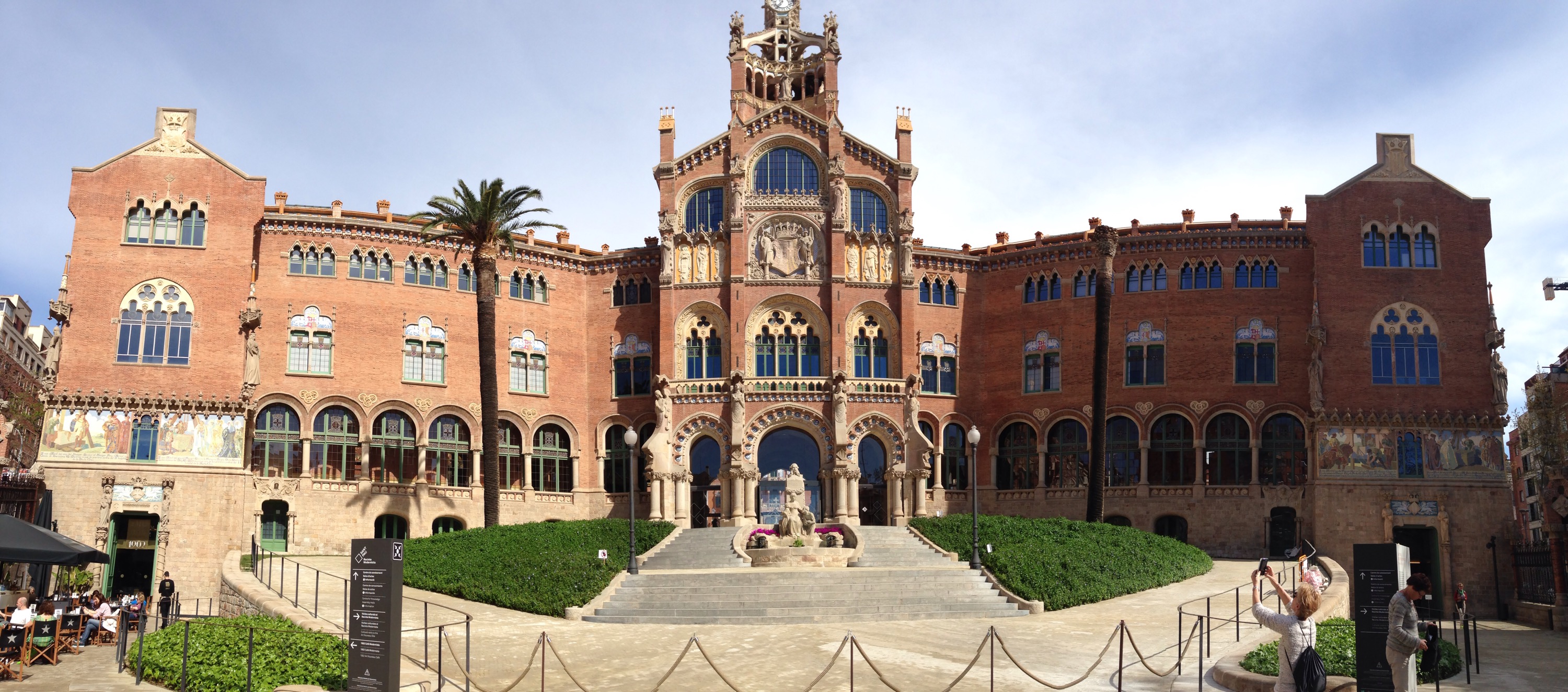
The Hospital de Sant Pau if the other half of the UNESCO World Heritage Site.
Retro Auto Moto Museum. Down a narrow side street, this museum has primarily Spanish cars, motorcycles and bicycles, all lovingly restored. I have seen so many of these old car museums that I found this one tiring and not worth the entry. €8 no reduction.
Mosaiccos. Holds classes in constructing mosaics with an emphasis on Gaudi styles. Go to www.mosaiccos.com – 2 hours €40, 3 hours €59 and 4 hours €77.
MEAM – European Museum of Modern Art. This is not abstract art, but figurative art with all artists still living, from around the world, and not to be missed. The highlight was the temporary exhibit of ARC, the American Art Revival Centre, a non-profit, educational foundation, that promotes realist art in the USA, and holds an annual competition, now the 13th International ARC Salon that drew 3750 entries from 69 countries and gave $100,000 in awards in 10 categories at a ceremony at MEAM. The two previous showings were in New York and Los Angeles. Many of the works were for sale and truly spectacular – I thought many were photographs. The permanent exhibition is on the upper two floors and not quite as enjoyable. There were many nudes.
Cathedral of Barcelona (Cathedral of the Holy Cross and Saint Eulia, is a Gothic cathedral and seat of the Archbishop of Barcelona. It was constructed from the thirteenth to fifteenth centuries. In the late nineteenth century, the neo-Gothic façade was constructed over the nondescript exterior that was common to Catalan churches. The roof is notable for its gargoyles, featuring a wide range of animals, both domestic and mythical.
It is a pseudo-basilica, vaulted over five aisles, the outer two divided into chapels.
The cathedral is dedicated to Eulalia of Barcelona, co-patron saint of Barcelona, a young virgin who, according to Catholic tradition, suffered martyrdom during Roman times in the city. One story says that she was exposed naked in the public square and a miraculous snowfall in mid-spring covered her nudity. The enraged Romans put her into a barrel with knives stuck into it and rolled it down a street.
Many think Familia Sagrada it the Barcelona cathedral, but it isn’t. The grand Gothic church has a great façade, and double aisles. €7
Palau Reial Major. The Royal Palace contains the Museum of Barcelona showing 2000 years of archaeology from Rome and the Visigoths to the present and includes the palace, the residence of the Crown of Aragon. €7, €5 reduced
When I returned to my van, the back window was shattered and my Kindle was stolen – another example of the intense criminality of Barcelona. These are smash-and-grab operations, he didn’t take the very expensive sleeping bag of puff jacket. Thankfully I had put my computer on the floor between the seats before I left. After 45 minutes of cleaning up all the glass, I drove down to the nearby police station to fill out a police report for insurance. I called Amazon to deactivate the Kindle so it will never be of any value to the thief. I slept on the street about a block away with only the pull-down blind covering the window.
Day 3
After having a quick look around the flea market in Encants, I drove 6 km to a VW dealer who sent me on a 7km drive to the Commercial Van Center where I was informed the only place with this window was in Germany. They covered the hole with cardboard. Because of the long delivery time wherever I will be, my best bet is to see a dealer in Rome (about a week away), order the window and have it repaired on my way back through Rome 10 days later.
Hotel Arts is a 44-story, 154m tall, 483-room luxury hotel on the seafront operated by Ritz-Carlton. The facade is unusual with a steel girder structure on the outside.
The hotel underwent a complete renovation in 2006, installing new technology and upgrading the rooms and bathrooms into modern, luxurious spaces. Its pool is surrounded by gardens and offers guests the chance to sunbathe next to one of Barcelona’s most famous pieces of contemporary public art—a monumental golden fish-like sculpture by Frank Gehry, that was created for the ’92 Games.
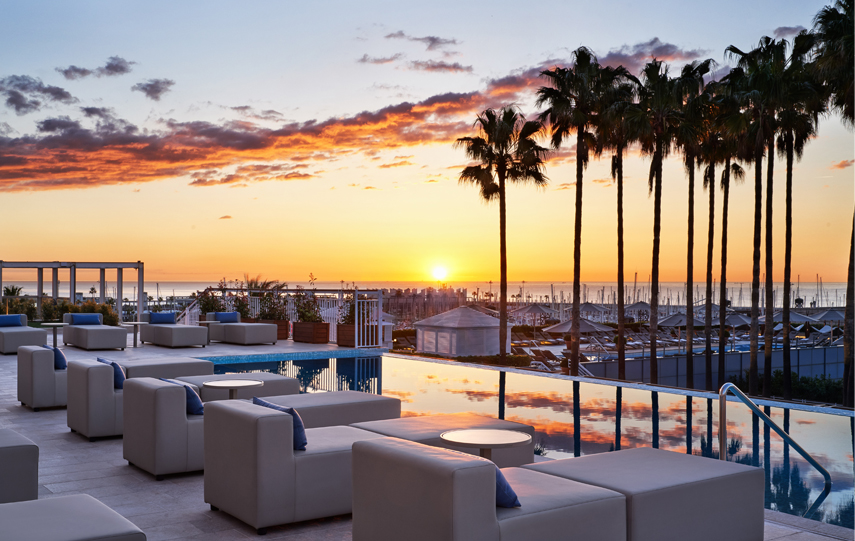
Hotel Diagonal Zero. In the NM “modern architecture series, this is close to the beach and the convention center, the Forum auditorium and the Diagonal Mar shopping centre. 262 rooms of all varieties, spa, swimming pool on the 17th floor and VIP floor.
Sharma Climbing BCN. This is a large bouldering climbing gym with most of the climb’s difficult overhangs. I didn’t see many getting to the tops. But even at noon on a Friday, it was crowded with a great atmosphere. A group of small kids was having great fun on the one top-rope climb. They offer climbing courses, children’s programs, outdoor climbs and rent gear. The American, Chris Sharma is one of the world’s leading climbers and I am guessing he owns or is affiliated.
A day pass was €14, 5 sessions €65, 10 sessions €110, 1 month €59, 3 months €160 half-year €300 and one-year membership €550.
Torre Mapfre is a skyscraper in the Olympic Port, the maritime neighbourhood of the Old City of Barcelona. It is named after its owner, Mapfre, an insurance company. It is primarily office space for at least 18 separate businesses. This tower holds the title for the highest helipad in Spain at 154 m (505 ft) above ground. Unlike its twin, Hotel Arts, this tower is a mixed-use tower.
Hotel Arts is a 44-story, 154m tall, 483-room luxury hotel on the seafront operated by Ritz-Carlton. The facade is unusual with a steel girder structure on the outside.
The hotel underwent a complete renovation in 2006, installing new technology and upgrading the rooms and bathrooms into modern, luxurious spaces. Its pool is surrounded by gardens and offers guests the chance to sunbathe next to one of Barcelona’s most famous pieces of contemporary public art—a monumental golden fish-like sculpture by Frank Gehry, that was created for the ’92 Games.

Mirado de Colom (Columbus Monument) is a 60 m (197 ft) tall monument to Christopher Columbus at the lower end of La Rambla. It was constructed for the Exposición Universal de Barcelona (1888) in honour of Columbus’ first voyage to the Americas. The monument serves as a reminder that Christopher Columbus reported to Queen Isabella I and King Ferdinand V in Barcelona after his first trip to the new continent.
At the very top of the monument stands a 7.2 m (24 ft) tall bronze statue depicting Columbus pointing southeast towards the New World with his right hand atop a 40 m (131 ft) tall Corinthian column. An elevator inside the column takes visitors up to a viewing platform at the top (just below the socle).
The canted octagonal plinth is inset with eight bronze bas-relief panels that depict important scenes in Columbus’s first voyage to the Americas
Maritime Museum. Situated on the roundabout, this has the typical ship museum stuff with more ship models than you can digest. €10. €5 reduced
Port Vell. At the end of the Barcelona harbour, access this 55-hectare site with a mall, movie theatre complex and aquarium on a floating gangway. Across the inlet is the halfway tower for the Port Cable Car that runs up to Mount Montjuic. This is a return trip starting at Montjuic Castle. I had planned on taking the cable car up, but now was walking.
Barcelona Aquarium. This well-done aquarium has all the usual critters. €20, €18 reduced
History Museum of Catalonia. At the very terminus of the inlet, these are the usual exhibits on local history from prehistory to the present.
It was a long walk to the top of Montjuic. Almost at the top is a wonderful panoramic view of the entire harbour.
MONTJUIC
Montjuic Castle. Sitting on the summit of Montjuic, the major part of the building dates to 1671-97 with a large addition from 1800-53. It is huge with the main wall and moat extending well past the 4 bastions and the watchtower in the main fort. A brick barrel vault encircles it. Besides the views, the nicest part may be the moat graced with flower and hedge gardens. €5, €3 reduced
Port Vell Cable Car. The entrance is next to the castle. I originally thought I could board at the port and take it up to here, but it is a one-way cable car offering a round trip. It was closed for a technical inspection. €8.40
Barcelona Botanical Garden. From the castle, jump over the wide rock wall and head straight down on one of the many trails. Had many large pines and greenhouses – there were few flowers in bloom at this time of the year. €5
Olympic Stadium. Built in 1929 as part of the World Expo, it is still a very attractive stadium. You walk in front of the entrance on the way to MNAC. Free
Funicular of Montjuic. It was out of service.
Museo Naticional d’Art de Catalonia MNAC. The outstanding part of this museum is the grand building opened in 1929. The magnificent 2300 sq. ft Oval Room seats 1900 people on the bleachers on three sides. Most of the art here is religious art emphasizing Catalonian painters. Many small domes with Christian art are in the main display. €12
The plaza in front has stairs with several fountains leading down to the main part of the city.

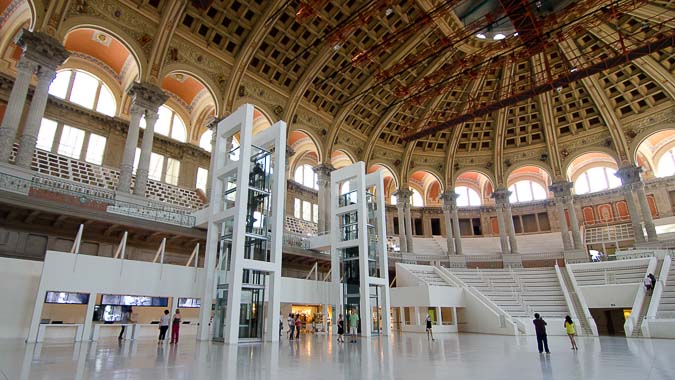
Barcelona Pavilion Designed by Ludwig Mies van der Rohe, it was the German Pavilion for the 1929 International Exposition in Barcelona and was used for the official opening of the German section of the exhibition. It is an important building in the history of modern architecture, known for its simple form and its spectacular use of extravagant materials, such as marble, red onyx and travertine. The same features of minimalism and spectacular can be applied to the prestigious furniture specifically designed for the building, including the iconic Barcelona chair. It has inspired many important modernist buildings. €5
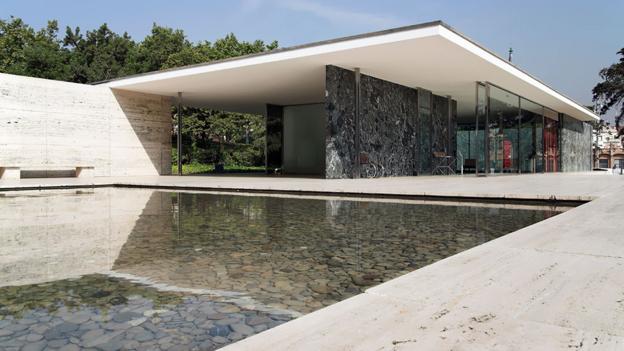 CaixaForum Barcelona is an art gallery sponsored by Barcelona bank “la Caixa”, and opened in 2002 in a former factory. The building was originally commissioned as a textile factory by Casimir Casaramona i Puigcercós, and built by the famous Catalan architect Josep Puig i Cadafalch. Called the “Casaramona factory”, it was completed in 1911, and the same year won the City Council’s award for best industrial building. The building is a wonderful brick-and-wrought iron Art Nouveau building. One of the first to use electricity, it also initiated preventative measures and became a leader in good working conditions. The crenellated rooflines drew their inspiration from medieval castles. One of the permanent exhibits highlights the building. It has almost three acres of exhibition space, a media library, an auditorium, classrooms and a restaurant. There are 5 salons with the present exhibits on Diego Velaquz (1599-1660), Joseph Deuy, Beckman and Poetics in Motion. €4 for the permanent exhibits.
CaixaForum Barcelona is an art gallery sponsored by Barcelona bank “la Caixa”, and opened in 2002 in a former factory. The building was originally commissioned as a textile factory by Casimir Casaramona i Puigcercós, and built by the famous Catalan architect Josep Puig i Cadafalch. Called the “Casaramona factory”, it was completed in 1911, and the same year won the City Council’s award for best industrial building. The building is a wonderful brick-and-wrought iron Art Nouveau building. One of the first to use electricity, it also initiated preventative measures and became a leader in good working conditions. The crenellated rooflines drew their inspiration from medieval castles. One of the permanent exhibits highlights the building. It has almost three acres of exhibition space, a media library, an auditorium, classrooms and a restaurant. There are 5 salons with the present exhibits on Diego Velaquz (1599-1660), Joseph Deuy, Beckman and Poetics in Motion. €4 for the permanent exhibits.
Plaça Espanya. The monumental fountain that rises up in the centre of the Plaça Espanya is one of the iconic images of this part of Barcelona, one visible from any corner of the plaza. This sculptural ensemble marks the gateway to the avenue leading to the grounds of the 1929 International Exhibition. It pays tribute to water with many noucentista-style sculptural elements that decorate the fountain.
Arenas de Barcelona. Built in 1900 as a bullring that operated until 1977. It was converted into a mall in 2014. With a Mudéjar façade, this huge mall has 5 floors of the usual shopping mall stores. Take the exterior elevator to the top with great views of this part of Barcelona from the large mirador encircling the entire top.

Sant Antoni Market. The original market with its iron girder structure and tiled exterior was built in 1882 and remodelled into a market in 2014, It is the largest fresh food market in Barcelona. It is a delight to just look at all the food.
La Boqueria Market. Housed in an old steel-framed building bordering on La Rambla, this large fresh food market also has tapas bars.
On February 16th, I finally left Barcelona and started to drive towards France.
Platja d’Ocala. About 10 km north of Barcelona, this is a great, deep sandy beach. Unfortunately, the fenced rail line separates the highway and the town from the beach. Cross on a few raised walkways.
Tossa de Mar. In the NM “small town” series, this seaside resort has narrow old alleys, a castle and loads of hotels and restaurants. The one-way drive along the ocean is not to be missed.
Ruinas de Empúries. Situated right on the shore about 50 km north of Barcelona, the ruins are very ordinary, with low stone walls and some recreated columns. The real reason to come here is the location and a good trail that fronts the shore. €5
After the ruins, I had the choice to go to Caldeques, where the Dali House Museum is. Even though Dali is my favourite artist (and I’ve seen much of his work including the museum in nearby Figueres), I decided the 50km detour was not worthwhile.

LE PERTHUS. This town sits on the Spanish side of the French border. It bustles with shoppers here for the cheaper Spanish products. On the top of the mountain west of the town centre, this grand Vauban fort has a short exterior brick wall, moat, a drawbridge that is operational and a double set of imposing walls surrounding a huge rectangular central “keep”. It doesn’t look like it is open often. I walked around the entire structure getting great views in all directions.
Le Perthus became French territory after the Treaty of the Pyrenees (1659). Bellegarde was captured by the Spaniards in 1674, but retaken by Schomberg in 1675. In 1678, Vauban’s plans for the new fortress of Bellegarde were approved.
During the War of the Pyrenees, the fortress was besieged in May – June 1793 by the Spanish and then by the French (May – Sept. 1794). During World War II, the fort was used as a holding prison by the Gestapo for escaped prisoners of war and enemy agents.
The fort is open to the public between June and September only and includes exhibits on the history of the fort, its archaeology and the surrounding area. €4
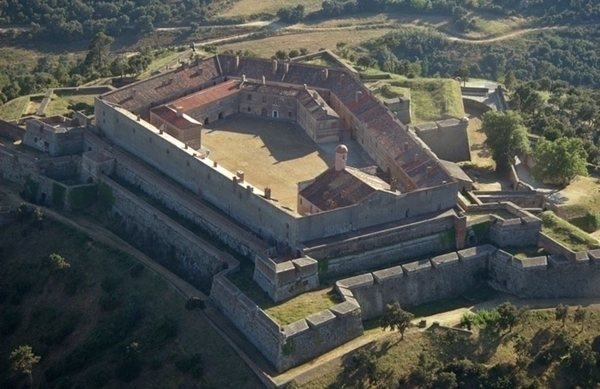
WORKS OF ANTONI GAUDI
Seven properties built by the architect Antoni Gaudí (1852–1926) in or near Barcelona testify to Gaudí’s exceptional creative contribution to the development of architecture and building technology in the late 19th and early 20th centuries. These monuments represent an eclectic, as well as a very personal, style which was given free rein in the design of gardens, sculpture and all decorative arts, as well as architecture. The seven buildings are: Parque Güell; Palacio Güell; Casa Mila; Casa Vicens; Gaudí’s work on the Nativity façade and Crypt of La Sagrada Familia; Casa Batlló; Crypt in Colonia Güell.
They reflect an eclectic, very personal style to which Gaudí gave free rein in the field of architecture, as well as in the design of gardens, sculptures, and indeed all the arts. Gaudí can be regarded as the most representative and outstanding of the Modernista architects.
